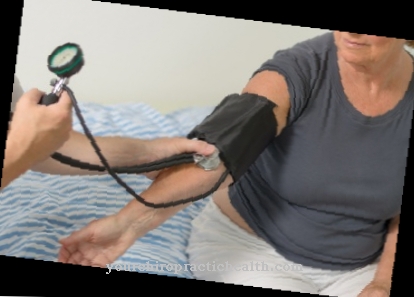At Diazepam it is a psychotropic drug from the group of tranquilizers. It is used primarily to treat anxiety and epilepsy. Diazepam is a benzodiazepine that is available under the trade name Valium has become known.
What is diazepam?

Diazepam As a psychotropic drug, it is one of the drugs that affect the human psyche. Psychotropic drugs can be subdivided into different substance groups. So one differentiates u. a. Neuroleptics, antidepressants, psychostimulants and tranquilizers.
Tranquillants (from the Latin tranquillare = to calm down, also known as tranquilizers) are substances that - in contrast to neuroleptics - have a calming effect without having an antipsychotic effect. They have an anxiety-relieving effect and ensure mental equilibrium without affecting mental performance too much. Tranquilizers make you tired and relax your muscles.
The tranquilizers can also be further divided into groups: The largest and most important of these groups are the so-called benzodiazepines. Benzodiazepines, which also include diazepam, are not only used as tranquilizers, but also as anti-epileptic drugs, i.e. H. used as a remedy for epilepsy.
Pharmacological effect
Diazepam works in the human nervous system. The part of the brain that is responsible for the generation of emotions (such as fear) and our instinctual behavior is called the limbic system.
Every form of stimulus within the nervous system - and thus also in the brain - is transmitted by nerve impulses. So that these stimuli can be transmitted from one nerve cell to the next, messenger substances - so-called neurotransmitters - are required. They are released from the excited nerve cell, overcome the cell boundaries and transmit the information to the next cell.
One such messenger is gamma-aminobutyric acid (GABA). Benzodiazepines reduce the number of impulses passed on in the limbic system by having an inhibitory effect on the release of GABA.The anticonvulsant and anxiolytic effect of diazepam and other benzodiazepines results from the suppression of the conduction of states of excitement.
Medical application & use
Diazepam is available under various trade names: Valium, Faustan, Lamra, Tranquase, Valiquid, Diazepam Stada, Diazepam-ratiopharm and many more.
There are different dosage forms for treatment with diazepam: The drug can be administered intravenously or rectally. When administered intravenously, the effect is rapid, i. within one to two minutes. When applied to the rectum, the onset of action can be delayed; in both cases, clear effects are noticeable after ten minutes at the latest. Both the duration and the intensity of the effect are dose-dependent.
In clinical medicine, diazepam is mainly used for a limited period in the treatment of tension and anxiety and in epilepsy. In emergency medicine, diazepam is mainly used for severe agitation, anxiety and panic attacks, seizures, greatly increased muscle tone and for analgesia (simultaneous administration of sedatives and painkillers) of ventilated patients.
The administration of diazepam for seizures is not without controversy and is only rarely practiced because the risk of injury to the patient when administering the medication is very high.
Diazepam can be given preventively as a sedative before stressful situations. Since the risk of dependency increases rapidly with repeated application and the body quickly develops a tolerance to the active ingredient, many doctors see the administration of diazepam as contraindicated in such cases.
You can find your medication here
➔ Medicines for panic attacks and anxiety
Risks & side effects
Diazepam has a variety of side effects: In addition to fatigue and dizziness, the muscle-relaxing effect can slow down breathing.
Nausea and vomiting can also occur. Occasionally a slight drop in blood pressure can be observed. During pregnancy, in the event of kidney and liver damage and after taking alcohol, painkillers and sleeping pills, you should urgently refrain from giving diazepam! Benzodiazepines can - like all other tranquilizers - increase the effects of painkillers, alcohol and other psychostimulants.
Occasionally - especially in older patients - a so-called paradoxical mode of action is observed, i. H. the symptoms are not alleviated, but intensified. In extreme cases, the effect of diazepam can be antidoped by administering flumazenil.



























